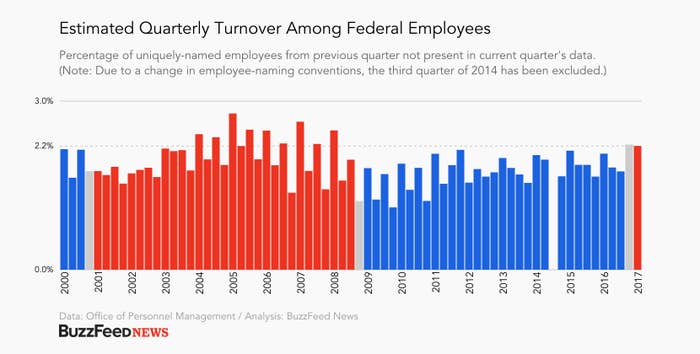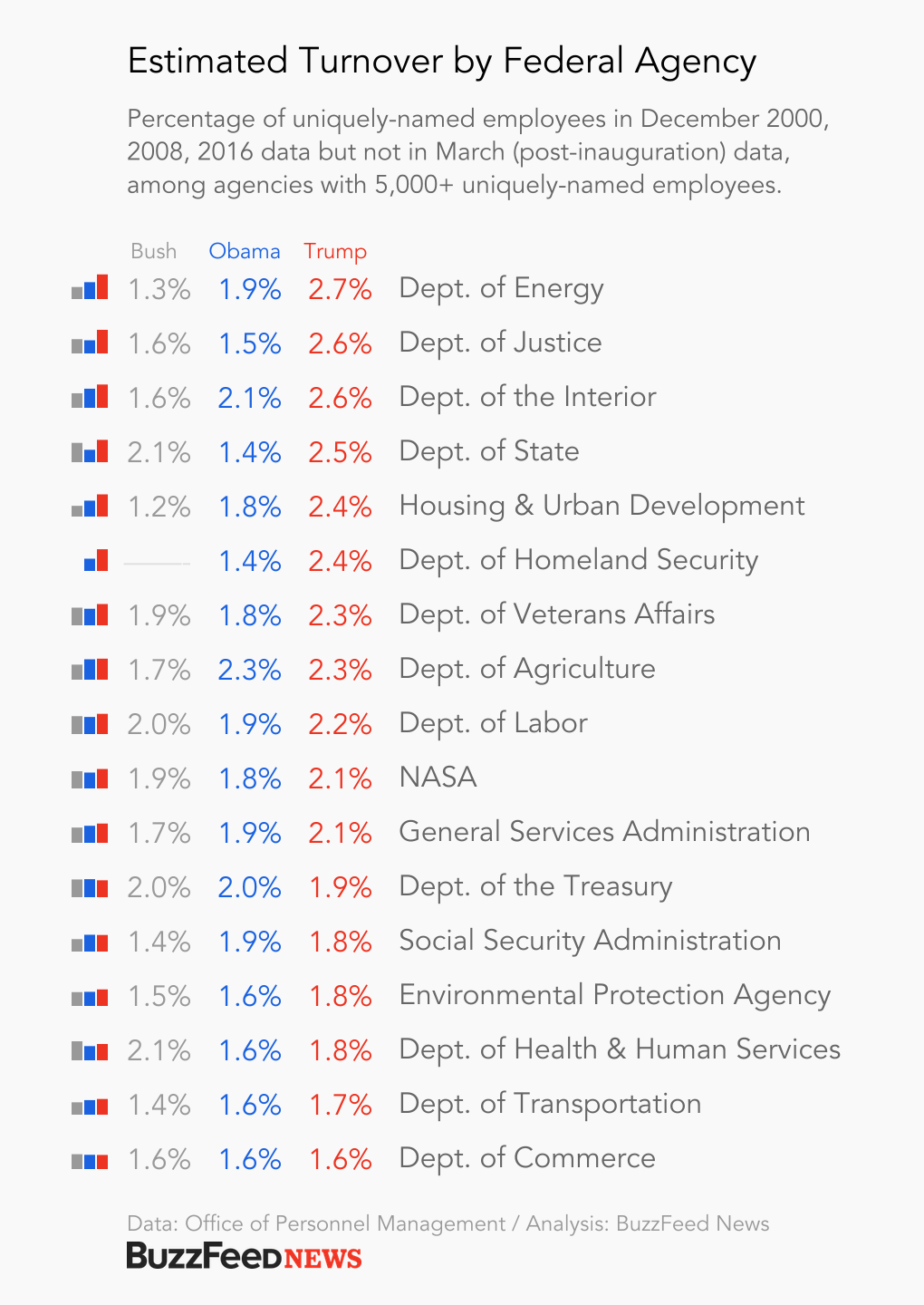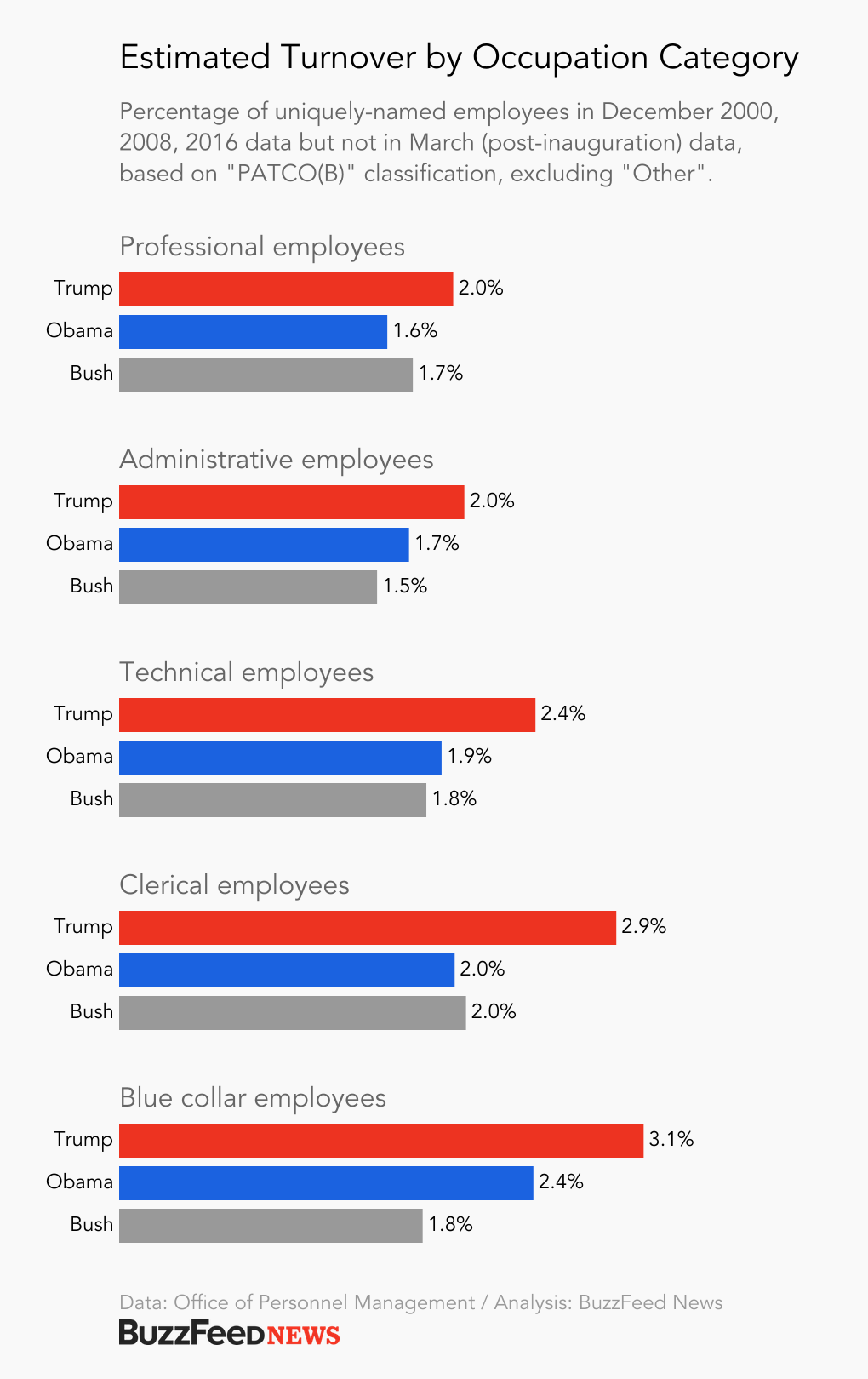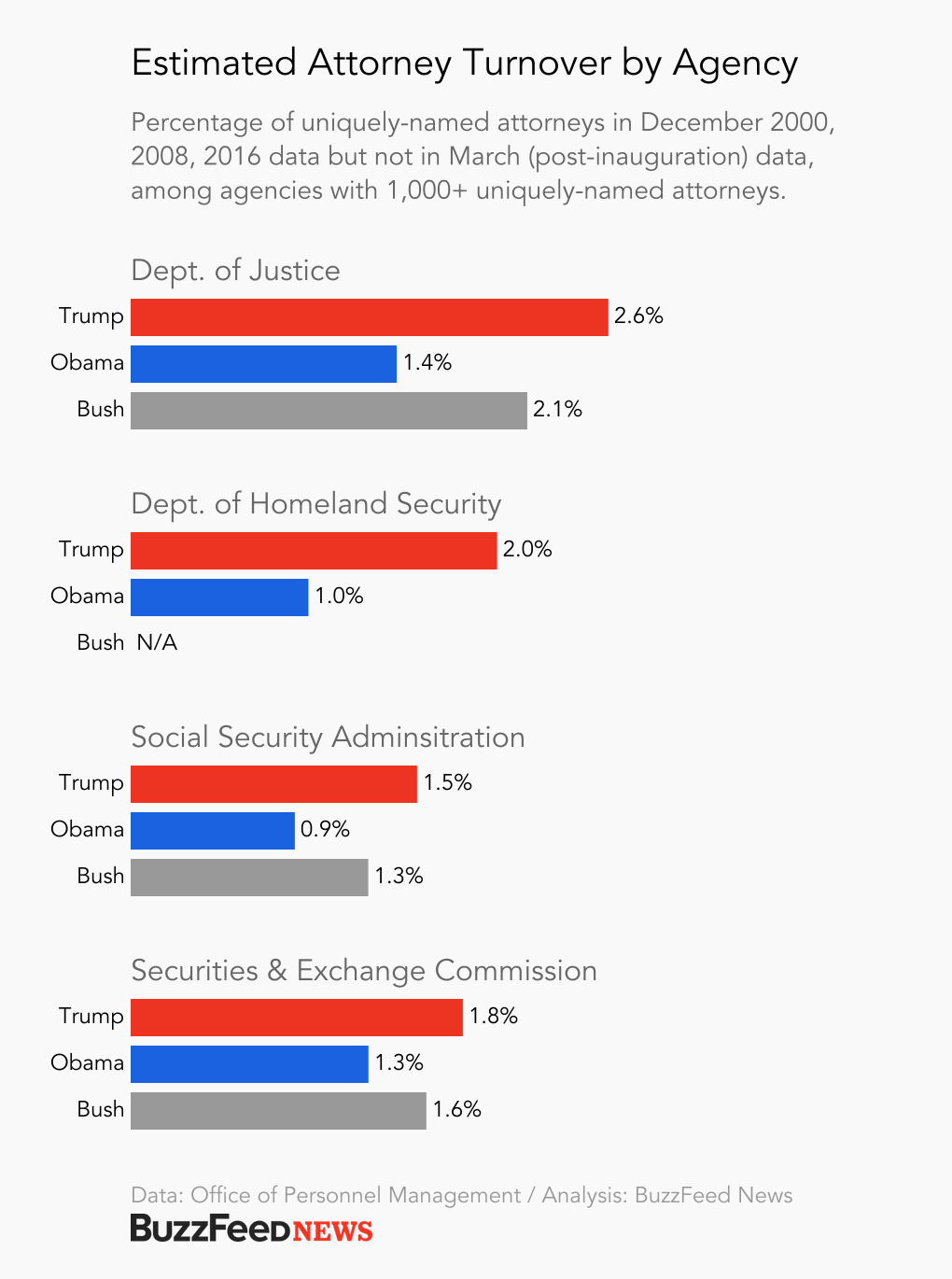In October, a survey of federal employees found that 27% might consider leaving their jobs if Donald Trump were elected. After he won the presidency, The Atlantic warned readers of “the coming exodus of career civil servants.”
But despite being one of American history’s least popular new presidents, and promising to reverse many of his predecessor’s policies, Donald Trump did not ignite an immediate mass exodus from the federal government, according to an exclusive BuzzFeed News data analysis.
Still, the rate of employees leaving appears to be higher than it was at any point in the early years of Barack Obama’s or George W. Bush’s presidencies.
An estimated 2.2% of full-time federal employees in the US departed between late December 2016 and late March 2017, according to the analysis, which is based on federal payroll data received via the Freedom of Information Act.
The details reveal some interesting patterns:
• Among large agencies, those with the highest departure rates were the Department of Energy, the Department of Justice, and the Department of the Interior.
• Overall, people whose jobs were classified as “professional” were less likely to leave than blue-collar or clerical employees. Patent examiners and accountants were among the least likely professionals to depart.
• College-educated employees weren’t any more likely to leave than employees with no bachelor’s degree.
Note: It is not yet possible, with the data currently available, to tell how many of the overall departures came from resignations, how many from firings, how many from retirements, and how many from other circumstances. And redactions from the data make it impossible to estimate the departure rates for the Department of Defense, the Postal Service, the Internal Revenue Service, and a handful of other agencies.
At the end of this post, you can find our methodology. You can also find all the code on GitHub and the underlying data on the Internet Archive.
Every three months, somewhere between 1% and 3% of federal employees leave their jobs.

Using data provided by the Office of Personnel Management (OPM), we calculated the percentage of uniquely named, full-time, nonseasonal employees who (a) appeared in the end-of-quarter payroll data for one fiscal quarter, but (b) not the next. We excluded political appointees, who routinely leave whenever a new president takes office.
(See the methodology at the end of the post for why we think this approach works well.)
By this metric, the 2.2% turnover rate in the first three months of 2017 was higher than the same periods after Barack Obama (1.8%) or George W. Bush (also 1.8%) were elected. It was also higher than at virtually any point during Obama’s presidency and most of Bush’s eight years in office. (The departure rate between the end of September 2016 and the end of December 2016 was also 2.2%, but it’s not possible to determine how many departures occurred before or after after the Nov. 8 election.)
Still, as you can see in the chart above, the departure rate in in Trump’s first months wasn’t enormously higher than usual. (Data from federal retirement claims appear to support these findings; the number of new claims this January was nearly identical the number last January.)
Even among career employees of the Senior Executive Service — who serve political appointees more directly and were the focus of The Atlantic’s “exodus” warning — the departure rate after Trump’s election (3.0%) wasn’t much higher than after Obama’s election (2.5%) and slightly lower than after Bush’s (3.2%).
The Department of Energy had the highest turnover rate of any large agency.
Other departments with high rates of employees leaving were Justice, the Interior, State, and Housing & Urban Development. The Department of Commerce had the lowest.
The Environmental Protection Agency saw sub-average turnover, however, despite the fact that Trump appointed Scott Pruitt, a vociferous critic of the agency, to lead it. (The data does not include employees who left after March, such as the hundreds of EPA employees who've taken buyouts in recent weeks — "a wave of departures that soon could take the agency’s staffing to its lowest point in almost 30 years," the Wall Street Journal reports.)

People whose jobs were classified as “professional” were less likely to leave than blue-collar or clerical employees.
All three groups of employees were also more likely to leave soon after Trump’s election than soon after Obama’s first election. (This is based on the “PATCOB” occupation classifications used in the OPM data.)

Patent examiners and accountants were among the least likely to depart.
...based on an analysis of “professional”-classified occupations with at least 5,000 uniquely named employees in December 2016.

Lawyers at the Department of Justice and the Department of Homeland Security were more likely to leave after Trump’s election than after Obama’s.

College-educated employees weren’t more likely to leave than employees with no bachelor’s degree.

How we analyzed the data
Through a series of Freedom of Information Act requests to the Office of Personnel Management (OPM), BuzzFeed News obtained federal payroll data for every fiscal quarter from 1973 to March of this year — the most recent data currently available.
In response to our first request — corresponding to payrolls before mid-2014 — the data that OPM provided contained an especially useful column, called the “Pseudo ID.” That column helped track employees over time, even if they had a common name, transferred agencies, et cetera. (One exception: This identifier changed when when employees moved into privacy-protected positions, such as correctional officers and nuclear engineers.) But after OPM suffered a massive hack, revealed to the public in April 2015, the agency stopped including this column in the data it provided.
That’s the bad news. The good news: We found an alternative approach that seems to approximate employee turnover with a high degree of accuracy. Here’s what we did: For each end-of-quarter payroll, we selected all the uniquely named full-time employees — those with names that no other named full-time employee had. Then, we calculated the percentage of those names (excluding political appointees) that did not appear in the next quarter’s data.
This approach faces a few challenges. For instance, it is fooled by employees who change their names. Many employees names’ are redacted in the data, including all correctional officers, nuclear engineers, and certain other occupations, as well as everyone who works for the Department of Defense, the Postal Service, the IRS, and a handful of other agencies. It also ignores people with common names.
Ultimately, we’re left with 549,000 to 690,000 uniquely named employees per quarter.
Despite all that, it appears to work. Between 2000 and mid-2014, when the “Pseudo ID” was available, the approach was, on average, less than a tenth of a percentage (0.1%) different than the rate based on the Pseudo ID. (This excludes mid-2006, when the Department of Justice changed the Pseudo IDs for a large number of unnamed employees.)
You can find the code that runs these analyses, and their outputs, on GitHub.
